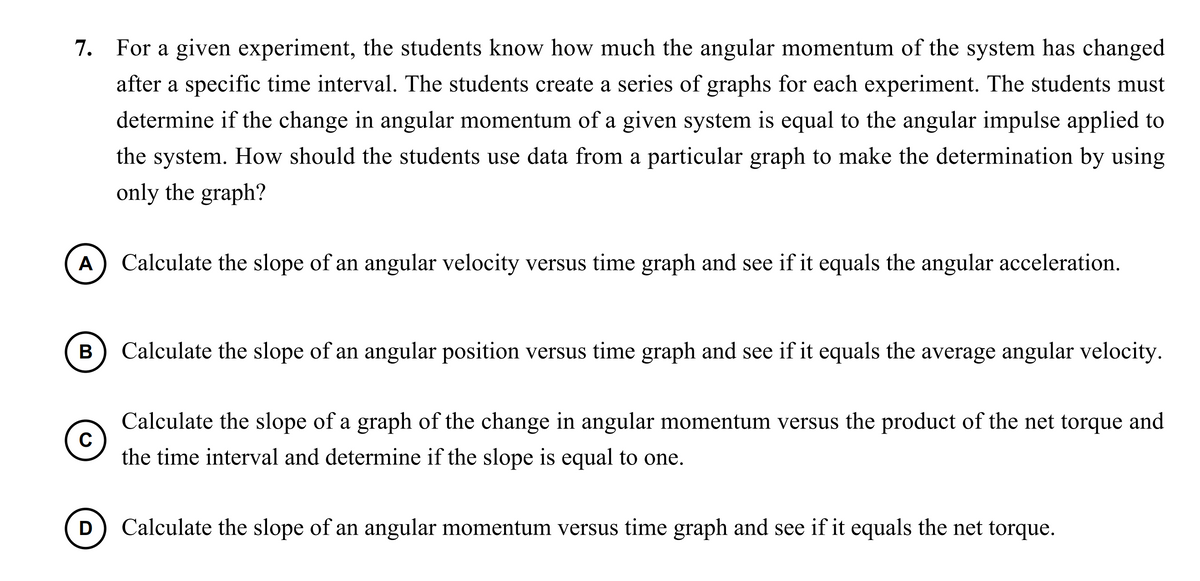7. For a given experiment, the students know how much the angular momentum of the system has changed after a specific time interval. The students create a series of graphs for each experiment. The students must determine if the change in angular momentum of a given system is equal to the angular impulse applied to the system. How should the students use data from a particular graph to make the determination by using only the graph? A Calculate the slope of an angular velocity versus time graph and see if it equals the angular acceleration. B Calculate the slope of an angular position versus time graph and see if it equals the average angular velocity. Calculate the slope of a graph of the change in angular momentum versus the product of the net torque and the time interval and determine if the slope is equal to one.
7. For a given experiment, the students know how much the angular momentum of the system has changed after a specific time interval. The students create a series of graphs for each experiment. The students must determine if the change in angular momentum of a given system is equal to the angular impulse applied to the system. How should the students use data from a particular graph to make the determination by using only the graph? A Calculate the slope of an angular velocity versus time graph and see if it equals the angular acceleration. B Calculate the slope of an angular position versus time graph and see if it equals the average angular velocity. Calculate the slope of a graph of the change in angular momentum versus the product of the net torque and the time interval and determine if the slope is equal to one.
Physics for Scientists and Engineers with Modern Physics
10th Edition
ISBN:9781337553292
Author:Raymond A. Serway, John W. Jewett
Publisher:Raymond A. Serway, John W. Jewett
Chapter11: Angular Momentum
Section: Chapter Questions
Problem 10P: Heading straight toward the summit of Pikes Peak, an airplane of mass 12 000 kg flies over the...
Related questions
Question

Transcribed Image Text:7. For a given experiment, the students know how much the angular momentum of the system has changed
after a specific time interval. The students create a series of graphs for each experiment. The students must
determine if the change in angular momentum of a given system is equal to the angular impulse applied to
the system. How should the students use data from a particular graph to make the determination by using
only the graph?
A
Calculate the slope of an angular velocity versus time graph and see if it equals the angular acceleration.
Calculate the slope of an angular position versus time graph and see if it equals the average angular velocity.
Calculate the slope of a graph of the change in angular momentum versus the product of the net torque and
C
the time interval and determine if the slope is equal to one.
Calculate the slope of an angular momentum versus time graph and see if it equals the net torque.
Expert Solution
This question has been solved!
Explore an expertly crafted, step-by-step solution for a thorough understanding of key concepts.
This is a popular solution!
Trending now
This is a popular solution!
Step by step
Solved in 2 steps with 2 images

Knowledge Booster
Learn more about
Need a deep-dive on the concept behind this application? Look no further. Learn more about this topic, physics and related others by exploring similar questions and additional content below.Recommended textbooks for you

Physics for Scientists and Engineers with Modern …
Physics
ISBN:
9781337553292
Author:
Raymond A. Serway, John W. Jewett
Publisher:
Cengage Learning

Physics for Scientists and Engineers
Physics
ISBN:
9781337553278
Author:
Raymond A. Serway, John W. Jewett
Publisher:
Cengage Learning

Physics for Scientists and Engineers, Technology …
Physics
ISBN:
9781305116399
Author:
Raymond A. Serway, John W. Jewett
Publisher:
Cengage Learning

Physics for Scientists and Engineers with Modern …
Physics
ISBN:
9781337553292
Author:
Raymond A. Serway, John W. Jewett
Publisher:
Cengage Learning

Physics for Scientists and Engineers
Physics
ISBN:
9781337553278
Author:
Raymond A. Serway, John W. Jewett
Publisher:
Cengage Learning

Physics for Scientists and Engineers, Technology …
Physics
ISBN:
9781305116399
Author:
Raymond A. Serway, John W. Jewett
Publisher:
Cengage Learning

Glencoe Physics: Principles and Problems, Student…
Physics
ISBN:
9780078807213
Author:
Paul W. Zitzewitz
Publisher:
Glencoe/McGraw-Hill

Principles of Physics: A Calculus-Based Text
Physics
ISBN:
9781133104261
Author:
Raymond A. Serway, John W. Jewett
Publisher:
Cengage Learning

College Physics
Physics
ISBN:
9781938168000
Author:
Paul Peter Urone, Roger Hinrichs
Publisher:
OpenStax College